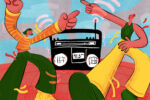Mastering an Instrument Made Easy
For those of you struggling to harness your inner musician, the ukulele may be just what you need.
By Joanne Paquin, Emerson College
I have always envied musicians.
To me, music is magic, and a day doesn’t go by where I don’t pop my earbuds in and let myself absorb the transfixing power of songs.
While riding the T, walking home from the grocery store or simply laying in my bed awaiting sleep, I play music. I let it control my mood or act as the basis for the stories I make up for people around me. When my mind is empty, I let the songs tell their own stories. I let their crescendos and decrescendos carry me up and down. Though I may be too introverted to bob my head to a beat on the bus, I let my mind dance along. I imagine the musician playing their song, with their fingers running over the guitar, piano or violin.
And then I think, I want to do that.

There’s comfort in music. There’s emotion, and there’s power. And while many people know this, musicians actually have a handle on it. That’s where the envy comes in. One has to wonder what it’s like to be able to make one’s own music, but being a musician is no easy task, particularly for the musically inept or not-so-virtuoso.
Even with a lot of time and practice, some people just can’t learn an instrument. I spent three years trying to learn how to play the guitar, but even after hours of lessons, my fingers still couldn’t move into the G-chord position without some struggle. It was disheartening because I wanted to play. I wanted to make music, but I just couldn’t make it work.
Then, my sister gave me a ukulele, a shrunken version of a guitar with two less strings. I thought maybe I could get a handle of it. A month later, though I was wrong about it being anything like the guitar, I was playing some of my favorite songs. A year later, my love for the uke has not diminished at all. I find it to be a simple instrument, something even the short-fingered can play, with lots of room for advancement. And learning to play is easy too.
1. Finding Your Size
Ukuleles come in four sizes: soprano, concert, tenor and baritone. For beginners, soprano ukuleles are usually recommended because they are frequently known as the “standard” ukulele, the one you may imagine being played on a Hawaiian Island, where the instrument’s name originated. They are bright in sound, small in size and typically more affordable than the other sizes.
Choosing an instrument is a personal matter. There are hundreds of options from varying brands, though Kala and Cordoba are two renowned ukulele-makers. Obviously, the more expensive ukes will be the better sounding/higher quality ones, but the cheaper ukes hold their charm as well.
You may have to tune them more frequently, but that’s okay. Just think of it as time to “bond” with your instrument.
Most sites suggest you can find a perfectly good ukulele for between $50 -$200, particularly when you’re just buying a beginner instrument. Avoid the cheap $20-$30 ukes because they won’t emit the sound you want, and if it doesn’t sound good, you won’t want to play it, which is discouraging.
After you find the right ukulele for you, be sure to invest in a case as well. Not only will it protect your instrument from harsh road trips, extreme weather or curious pets, but it will also help to keep your uke in tune. Even slight variances in temperature can change your instrument’s tuning, so keeping it in a case will help to hinder that.
No matter how well you maintain your uke, you’re still going to have to tune it. Clip-on tuners are available to buy, but there are also free apps that work just as well. Using them is simple. When you pluck each string, it will tell you what pitch it is at, and you can adjust the string’s tension accordingly.
2. Learning to Play
I found the easiest way to learn how to play the ukulele was by watching instructional videos on YouTube. “The Ukulele Teacher” is an excellent resource. He has hundreds of videos that teach you how to play varying songs, from “Here Comes the Sun” to “Chasing Cars” and “Call Me Maybe.”
He also takes song requests. Each video starts out by introducing you to the song’s chords and then the varying strum patterns. The guides move slowly, part-by-part, before “The Ukulele Teacher” invites you to join him as he plays the song in its entirety.
By watching these videos and playing along with “The Ukulele Teacher,” you become familiar with the layout of your uke and the different chord shapes needed to play different songs. You will learn which chords are common and how to position your fingers for difficult-to-play chords. You also learn how to play your favorite songs, which is fun! Once you’re familiar with that, you can move away from instructional videos and turn to tablature.
“Ukatabs” is another great resource for beginner ukulele players. The site has hundreds of songs available to learn for free, but rather than providing a video of someone playing the song, they simply show the chords or the tabs needed to play it. If you are unfamiliar with a certain chord, you can scroll over it to learn how to play it. If you want to change the key of the song, it’s as easy as hitting the transpose button, but it’s up to the player to come up with a strum pattern. A familiarity with the song you are learning will definitely help, but not knowing leads to some fun experimenting.
I think the ease of playing the ukulele comes from its small shape and four-string makeup. While the variances of chord shapes are numerous, they are all contained within a small space, which makes it easy to get from one chord shape to the next. The strings are also light, which makes pressing down on them and strumming them manageable (and not super painful like it is with guitars when you’re first starting out).
There is also something to be said of an instrument that hardly ever “sounds bad.” A misplayed chord will likely sound sweet. Random chord progressions may sound bright, and a mindless strum sounds soothing. When it’s hard to play the instrument poorly, you don’t want to put the uke down, which is exactly how one learns an instrument, right? By playing it a lot.


















[…] due to its smaller size and fewer strings, and basically sounding great however you strum it (https://studybreaks.com/2017/01/28/ukulele/). So there’s great motivation for anyone to go and learn […]
[…] if you cannot play a song right away, you can still play notes, you can hit multiple keys or strum multiple chords. A dance routine must be flawless, but there is no need to be perfect when learning an instrument. […]
[…] you learn to play the ukulele? Here are three things you need to know about it. Or you can visit this post on StudyBreaks about ukulele […]
[…] To start strumming, you need to know how to strum. If you plan to buy a ukulele, you should visit studybreaks.com. Thus, you could discover some recommended types and essential features. Despite those issues, […]